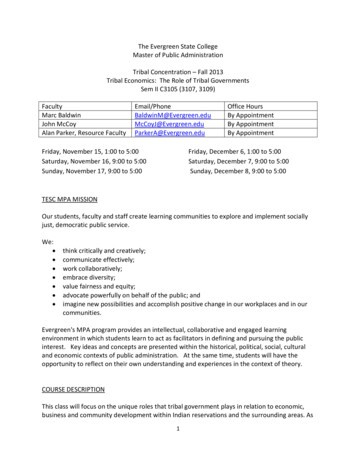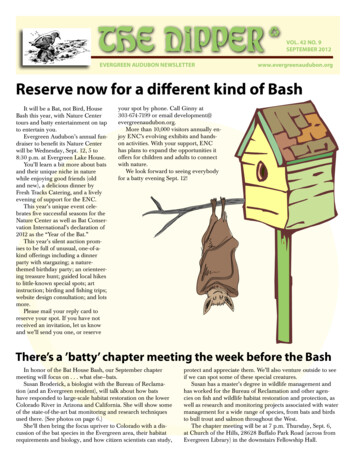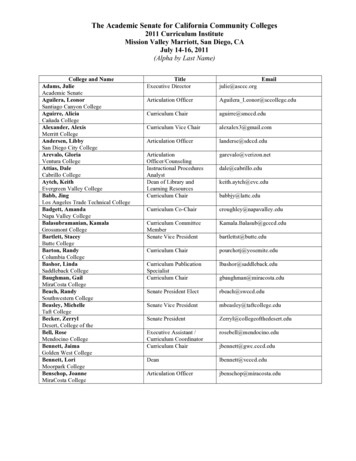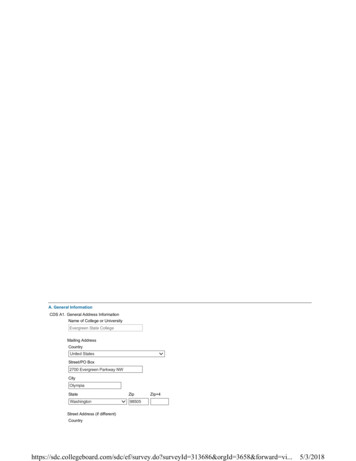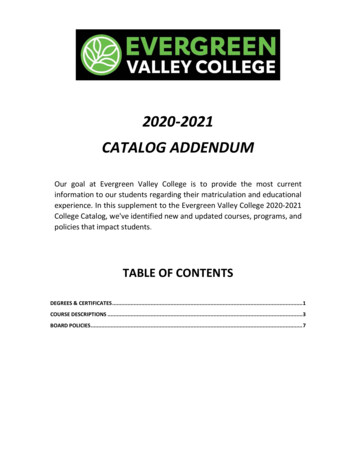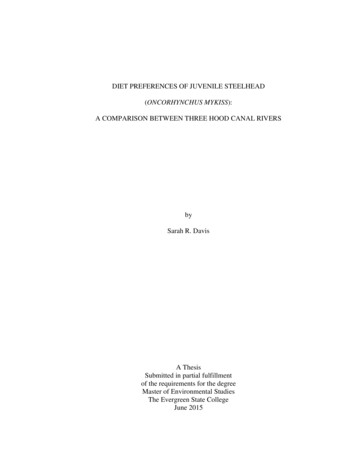
Transcription
DIET PREFERENCES OF JUVENILE STEELHEAD(ONCORHYNCHUS MYKISS):A COMPARISON BETWEEN THREE HOOD CANAL RIVERSbySarah R. DavisA ThesisSubmitted in partial fulfillmentof the requirements for the degreeMaster of Environmental StudiesThe Evergreen State CollegeJune 2015
2015 by Sarah R. Davis. All rights reserved.
This Thesis for the Master of Environmental Studies DegreebySarah R. Davishas been approved forThe Evergreen State CollegebyErin Martin, Ph. D.Member of the FacultyDate
ABSTRACTDiet preferences of juvenile steelhead (Oncorhynchus mykiss):A comparison between three Hood Canal riversSarah R. DavisHatchery programs have been established in Washington State for decades to supplementdeclining wild steelhead (Oncorhynchus mykiss) populations. However, these hatcheryprograms have been implemented with a limited understanding of how the introduction oflarge numbers of hatchery raised steelhead in Puget Sound river systems impact wildsteelhead populations. This information can inform current steelhead supplementationprograms throughout the Pacific Northwest by providing the composition and quantity ofimportant prey items and will allow for a better understanding of juvenile steelheadneeds. This study examined differences between wild and hatchery steelhead in threeHood Canal rivers of various sizes. Results showed that Ephemeroptera aquatic larvae arethe dominant items in the drift and the dominant prey items in wild and steelheadjuvenile diets. At the river scale, wild and hatchery steelhead diets were found to differsignificantly in the middle sized river (A 0.1617, p 0.001). At the reach scale, wild andhatchery diets were found to differ significantly in the lower reaches of the medium(A 0.0370, p 0.001) and large sized rivers (A 0.1230, p .001), but not in the smallriver. This could possibly be due to the lack of resources in the small river, where theabundance of items in the drift was lowest, and as such, fish had less selection, therebyeliminating differences between wild and hatchery diet. This is consistent with theobservation that wild and hatchery diets were found to have a wider variety of prey itemsin the smallest size river. Furthermore, wild and hatchery fish rejected fewer items
relative to the larger rivers, with wild fish consistently consuming all items availablerelative to drift. Overall, wild fish consumed a greater diversity of prey relative tohatchery fish. These results show that wild and hatchery steelhead have been found toconsume different items in some rivers and reaches and that river size seems to influencethe number of items available. These diet differences could possibly be due to rearingenvironment differences or competition between wild and hatchery steelhead.
Table of ContentsList of Figures . vList of Tables.viiAcknowledgements.viiiCHAPTER I. Introduction . .1CHAPTER II: Literature Review .5CHAPTER II: Manuscript.32Introduction 32Methods .34Hood Canal Steelhead Project . 34Study Area .38Macroinvertebrate Drift Collection 41Steelhead Stomach Sampling .42Site Characteristics .43Data Analysis . 43Results . .48Drift Composition . 48Diet Composition . .50Diet Overlap . .55Electivity Index . .62Discussion . . 68CHAPTER IV: Conclusion . .76References . .80Appendix . .88iv
List of FiguresFigure 1 Diagrams of incomplete and complete metamorphosis (Lanham 1964) .23Figure 2. A map showing the locations of the supplemented (S) and control (C) streamsin Hood Canal. The Hamma Hamma River supplementation was terminated in 2007(Berejikian et al. study plan draft) . .35Figure 3 Percent abundance of drift items collected in the Dewatto River (A),Duckabush River (B) and South Fork Skokomish River (C) .50Figure 4 Percent abundance of items collected from Dewatto River (A) Duckabush River(B) and South Fork Skokomish River (C) wild and hatchery juvenile steelhead stomachcontents . .53Figure 5 Percent abundance of items collected from Dewatto River (A) Duckabush River(B) and South Fork Skokomish River (C) hatchery juvenile steelhead stomachcontents . .54Figure 6 Percent abundance of items collected from Dewatto River (A) DuckabushRiver (B) and South Fork Skokomish River (C) wild juvenile steelhead stomachcontents . 55Figure 7 Nonmetric multidimensional scaling (2D) showing the degree of diet overlapbetween wild and hatchery origin steelhead juveniles in the Dewatto River (A),Duckabush River (B) and South Fork Skokomish River (C) using the Bray-Curtissimilarity index. The proximity of the symbols indicates degree of similarity. Solidtriangles indicate hatchery steelhead, hollow triangles represent wild steelhead . 58Figure 8 Nonmetric multidimensional scaling (2D) showing the degree of diet overlapbetween river reaches in the Dewatto River (A), Duckabush River (B) and South ForkSkokomish River (C) using the Bray-Curtis similarity index. The proximity of thesymbols indicates degree of similarity. Solid circles indicate the upper reaches, hollowcircles indicate the middle reaches and hollow squares indicate the lower reaches (Note:The Dewatto River only contains upper and lower reaches, data was not collected in themiddle reach) . . .59Figure 9 Nonmetric multidimensional scaling (2D) showing the degree of diet overlapbetween wild and hatchery steelhead juveniles in the lower reaches of the Dewatto River(A), Duckabush River (B) and South Fork Skokomish River (C) using the Bray-Curtissimilarity index. The proximity of the symbols indicates degree of similarity. Solidtriangles indicate hatchery steelhead, hollow triangles represent wild steelhead .60Figure 10 Percent abundance of items collected from lower Duckabush River wild (A)and hatchery (B) juvenile steelhead stomach contents .61Figure 11 Percent abundance of items collected from lower South Fork SkokomishRiver wild (A) and hatchery (B) juvenile steelhead stomach contents . .62v
Figure 12 Vanderplog and Scavia Electivity Index of prey selectivity for wild andhatchery steelhead in the Dewatto River. Includes all items found in both the drift andsteelhead stomach contents. Grey bars represent wild steelhead, black bars representhatchery steelhead .65Figure 13 Vanderplog and Scavia Electivity Index of selectivity for wild and hatcherysteelhead in the Duckabush River. Includes all items found in both the drift and steelheadstomach contents. Grey bars represent wild steelhead, black bars represent hatcherysteelhead . .66Figure 14 Vanderplog and Scavia Electivity Index of selectivity for wild and hatcherysteelhead in the South Fork Skokomish River. Includes all items found in both the driftand steelhead stomach contents. Grey bars represent wild steelhead, black bars representhatchery steelhead . .67vi
List of TablesTable 1 The physical attributes of the Dewatto, Duckabush and South Fork SkokomishRivers .38Table 2 The number of hatchery and wild fish included in the NMS/MRPP analysis ofthe Dewatto, Duckabush and South Fork Skokomish River. Types of prey items indicatesthe number of distinct prey categories included in the analysis . . 45Table 3 The number of hatchery and wild fish included in the Electivity Index analysis ofthe Dewatto, Duckabush and South Fork Skokomish River. Types of prey items indicatesthe number of distinct prey categories included in the analysis . .47Table 4. The number of wild and hatchery fish included in diet analysis on the DewattoRiver, Duckabush River and South Fork Skokomish River and the number of differentitem types found in stomach contents. Fish are broken down by reach, upper (U), middle(M) and lower (L) and the drift totals are combined for all river reaches . .51vii
AcknowledgementsErin Martin, Ph.D.Katy DoctorJulie Davis & Mark DixonKeith Davis & Uma SankarJoshua Davis, Jonathon Davis & Danielle HeckertBen, Chal & Lois MartinLaura Milleville & Chelsea Waddell2013-2015 MES Cohortviii
IntroductionPuget Sound steelhead (Oncorhynchus mykiss) play important cultural, economicand ecological roles in Washington State. Declines in Puget Sound steelhead populationsin recent decades led to the development of hatchery programs in the 1960’s and 1970’sdesigned to bring back historic steelhead populations (WDFW 2014a). The Puget Soundwild steelhead population has declined 97% since the 1800’s. In 1895, steelheadpopulations ranged from 330,000-820,000 fish, while the current population is at anaverage of 22,000 fish (WFC (b)). These hatchery programs have been implemented withlimited understanding of how the introduction of large numbers of hatchery raisedsteelhead in Puget Sound river systems impacts wild steelhead populations. Furthermore,despite these hatchery programs, steelhead populations have continued to decline. It isimperative that the interactions between wild and hatchery steelhead are betterunderstood so it can more clearly be determined if current hatchery practices are helpingor harming wild steelhead populations.Through better understanding of wild and hatchery steelhead feeding behaviors,hatchery programs can be developed in order to ensure that hatchery fish are notnegatively impacting wild populations. Diet analysis provides the composition andquantity of important prey items, allowing for a better understanding of juvenilesteelhead needs (Wright 2010). An understanding of juvenile steelhead diets while in thefreshwater ecosystem can inform current steelhead supplementation plans throughout thePacific Northwest, where large numbers of steelhead populations also continue todecline. Measures can be taken to allow for hatchery programs to more closely mimic1
the conditions experienced by wild juveniles through a better understanding of thefeeding habits and the factors that influence these feeding behaviors.A difference in diet and prey preference could have several implications forhatchery practices and management. A difference in diet and preference may reflecthatchery practices that are rearing fish that have diets not found in wild fish. This couldindicate that hatchery fish are not consuming the appropriate prey and are possibly notreceiving the nutrients needed to allow for their survival to maturity. However, dietdifferences may also indicate competition between wild and hatchery steelhead. If largerand more aggressive hatchery fish (Abbot 1985; Hill 2006; Keeley & McPhail 1998 &McMichael et al. 1999) are consuming the preferred items, wild fish may be forced tospecialize their diets, consuming the less desirable items that don’t require confrontationswith hatchery fish. Conversely, if the wild and hatchery juvenile populations are found tohave similar diets it may indicate that hatchery supplementation programs are rearing fishthat exhibit the same natural feeding patterns of wild fish.Differences in diet could also have implications in regards to trophic dynamics.Steelhead juveniles feed almost exclusively on macroinvertebrates found in the drift. Ifhatchery fish are consuming macroinvertebrates that are not often food items for wildfish, the food chain could be drastically altered. This is due to the role ofmacroinvertebrates in stream ecosystems. Macroinvertebrates influence nutrient cycling,primary production and decomposition (Wallace & Weber 1996). If the balance of theecosystem is geared toward what wild steelhead consume, introducing hatchery steelheadthat consume different macroinvertebrate species may impact these essential ecosystemfunctions.2
Understanding juvenile steelhead diets can also influence habitat restorationplanning. Food webs are not often considered when planning habitat restoration projects.By taking into consideration steelhead feeding habitats and including numerous habitattypes that allow for multiple feeding options, there is an increased chance that one ofthese habitats will become favorable to steelhead when environmental and ecologicalconditions change (Bellmore et al. 2013). This habitat restoration strategy will betterenable future steelhead populations to thrive in the face of continued anthropogenicimpacts including global climate change. Through the understanding of juvenilesteelhead diets and feeding behaviors, restoration teams can provide an environment thatwill provide juvenile steelhead with the resources necessary to ensure proper growth andsurvival of these populations. Combining this with the identification of wild and hatcherysteelhead diet preferences can provide the optimal combination of hatchery rearing andhabitat restoration practices that will allow for the most beneficial conditions to restorewild steelhead population levels in Washington and throughout the Pacific Northwest.In order to determine what the actual interactions are between wild and hatcherysteelhead I will be focusing specifically on juvenile wild and hatchery steelhead in threeHood Canal rivers: the Dewatto River, Duckabush River and South Fork SkokomishRiver. I will be attempting to answer the following research question: Do wild andhatchery steelhead juveniles exhibit different diet preferences and do these preferencesvary within rivers and between rivers? The middle, upper and lower reaches of theserivers is also of great importance to my study because it provides a more complete pictureof each river system and how habitat and prey dynamics may impact juvenile steelheaddiet and preference. These are three of six rivers included in a larger study, the Hood3
Canal Steelhead Project (HCSP), in which the effects of hatchery steelheadsupplementation are being examined. The three supplemented rivers included in thisstudy contain hatchery fish that were collected from these rivers, after spawning occurrednaturally, making them genetically wild. These eggs were then raised in a conservationhatchery setting where food and water temperatures were closely regulated.Following this introduction, a comprehensive literature review will provide an indepth look into steelhead life history, causes for steelhead population decline, theestablishment of Washington State fish hatcheries and the known impacts of hatcherysteelhead on wild populations. The second portion of the literature review will focusmore specifically on juvenile steelhead diets and feeding behaviors. It will also provide adetailed look into past and present research conducted in the area of juvenile steelheaddiet analysis. Next contains the findings of this study, presented in the form of amanuscript. The manuscript contains study background, methods used and data analysisconducted, as well as a discussion of the results and findings of the research questions.The final chapter focuses on the key findings of this research and the implications ofthese findings on steelhead management plans in Washington State and the PacificNorthwest.4
CHAPTER II: Literature ReviewPuget Sound steelhead populations have declined 97% since the 1800’s resultingin the development of hatchery programs in Washington State in an attempt to boost wildsteelhead populations. However, steelhead populations have continued to decline despitethese programs (WFC (b)). These hatchery programs have been implemented with alimited understanding of the interactions between wild and hatchery steelhead and howhatchery steelhead impact wild populations. It is imperative that these interactions arebetter understood to determine if current hatchery programs are truly helping to boostwild populations.Understanding juvenile steelhead diets while in freshwater systems is animportant element to consider when developing hatchery supplementation plans with thegoal of improving wild steelhead populations. Steps can be taken to allow hatcheryprograms to more closely align with the conditions experienced by steelhead juveniles inthe wild. For this to be possible, the feeding habits of wild and hatchery steelhead mustbe understood. This literature review will provide the background information needed tounderstand the complexities of wild and hatchery steelhead interactions and morespecifically, what factors have been found to influence wild and hatchery steelheadfeeding preferences and diet.Steelhead Life HistorySteelhead are anadromous salmonids. Adults return from the ocean to lay theireggs in freshwater rivers and streams where the eggs hatch and spend 1-2 years rearing infreshwater. Smolts out-migrate to the saltwater environment where they spend 1-3 years5
before returning to freshwater to spawn (Sheppard 1972; Quinn 2005). Native steelheadpopulations extend from the Bering Sea to southern California. Steelhead have beenintroduced to freshwater lakes and streams in the United States, Canada, Europe, SouthAmerica, Africa and Asia (Gilbert & Williams 2002; Krueger & May 1991). Within theUnited States steelhead have been introduced to the Appalachian Mountains (Krueger &May 1991) and in the late 1800’s steelhead were introduced to the Great Lakes (Seelbach1993).EmbryosThe length of time it takes for steelhead egg development is temperaturedependent. On average the eggs need 50 days of 10 C water. For every degree below10 C, the eggs will need an additional day of incubation and for every degree above 10 Cthe eggs need one less day of incubation (Sheppard 1972). Water temperatures varyextensively between rivers resulting in a wide range of steelhead incubation periods.Eggs that are laid in cooler streams will require much longer incubation periods than eggsin warmer water temperatures. For example, steelhead eggs laid in a stream with anaverage temperature of 5 C, will take 68 days to hatch, while in contrast, eggs in a streamwith 11 C water will only require 28 days of incubation. This acceleration of hatching inwarmer waters is due to the fact that higher temperatures increase metabolic rate and soincrease the rate of development. Salmonid embryos, including steelhead, survive best inwater temperatures between 5-11 C. Any temperatures below 2 C or above 14 C arelethal (Quinn 2005). Eggs are typically incubating from March to May, depending onwhen spawning occurred (Sheppard 1972).6
Dissolved oxygen (DO) is the second most important factor in determining thetime required between fertilization and hatching and can actually have a slowing effect insteelhead development in warm water temperatures. This is due to the fact that DOconcentrations decrease with warmer temperatures because of the water’s limitedcapacity to hold oxygen at higher temperatures. However, metabolic rate of embryodevelopment increases with these warmer temperatures requiring a higher exchange ofoxygen that is not readily available, resulting in delayed hatching. A decrease in DOconcentrations at 10 C can delay the hatching of steelhead by 35-40 days, depending onthe decrease in DO concentration (Quinn 2005). Therefore, water temperature is the mainfactor in determining the length of time required between egg fertilization and hatching,but DO levels can also add extra time to embryo development when water temperaturesare high.Alevins and FryAfter hatching, steelhead briefly enter the alevin stage, which occurs while stillwithin the gravel of the redd. Alevins still have a yolk sac attached to their bodies toprovide nutrients until they become large enough to capture sufficient amounts of food.Immediately after hatching alevins bury themselves deeper into the gravel, then graduallymove up through the stream’s substrate. Fry emerge from the gravel completely once theyolk sac has been absorbed, emerging as fry. The length of the alevin life stage is relatedto the same water temperature and DO factors that influence embryonic development(Quinn 2005).7
Once the steelhead fry emerge they feed on microscopic organisms floating by inthe current. As juvenile steelhead grow larger in size, they move to deeper parts of thestream to establish feeding territories where there are larger rocks and riffles. Steelheadjuveniles will stay in freshwater for an average of one to four years before they beginsmoltification (Busby et al. 1996).SmoltsDuring smoltification juvenile steelhead undergo physiological changes thatprepare them for their entrance into salty ocean waters. Steelhead smolts can out migrateto the ocean any time during the year but the majority migrates from April to June, withthe peak occurring in mid-April. However, some steelhead never migrate to the oceanand become resident steelhead, also referred to as rainbow trout (Sheppard 1972).Marine AdultsOnce steelhead smolts reach the ocean, they begin a rapid growth process,reaching 5-30 lbs after two to three years (Sheppard 1972), though they can continue togrow larger once they return to the ocean after spawning. This rapid growth is due to thelarge amount of food available in the marine environment (Sheppard 1972). While in theocean, steelhead feed on zooplankton, krill, squid, amphipods and schooling fish such asherring and sand lance (Sheppard 1972 & Quinn 2005). The distance that steelhead willtravel while in the ocean varies greatly by population. Steelhead in the Pacific Northwesthave been found to travel west to Kamchatka Peninsula in Russia. However, not allsteelhead will travel that great a distance with some southern Oregon and northern8
California populations only spending one summer at sea (Busby et al. 1996 & Quinn2005).Spawning AdultsThere are two steelhead runs, winter run and summer run. The winter runsteelhead begin to enter their natal stream in October and November, with the highestnumbers occurring in January through March. Winter steelhead spawning occurs fromlate March to early May (Sheppard 1972). The summer steelhead, often referred to as“stream maturing” (Quinn 2005), begin to enter their native streams in late spring andsummer, with highest densities generally reached in the late summer months of Augustthrough September. Summer run steelhead enter the rivers as sexually immature adultsand remain in freshwater until they reach sexual maturity and spawn the following spring(Sheppard 1972).Steelhead will spawn in main river channels and smaller side streams (Sheppard1972). Females dig redds in stream bottoms, where eggs are deposited andsimultaneously fertilized by males (Quinn 2005), with about 95% of the deposited eggsbecoming fertilized (Sheppard 1972). Once the eggs have been fertilized, the females willcover the redd with gravel to protect the eggs until the eggs hatch. Female steelhead mayhave multiple redds in a single spawning season with each successive redd containingfewer and fewer eggs. The average female steelhead ( 700m in length) will lay around5,000 eggs. Steelhead are iteroparous, which means they can survive spawning and repeatthe migration to the ocean and return to freshwater to spawn more than once (Quinn2005). Steelhead have been documented to make the journey from the ocean to spawn in9
freshwater as many as ten times (Anderson 2014), meaning that depending on whensmolting occurs, steelhead may live to be 15 years old.Steelhead Population DeclineThroughout the coastal and interior waters of the western United States, steelheadpopulations have been in decline in recent decades. Currently there are eleven steelheadpopulations protected under the Endangered Species Act (ESA) including: the Columbia,Snake and Willamette rivers, Central California Valley, the California coast, and thePuget Sound in Washington State (NOAA 2014). On May 11, 2007, Puget Soundsteelhead was listed as a threatened species. (Dept. of Commerce 2007), meaning that thisdistinct steelhead population is “likely to become endangered in the foreseeable futurethroughout all significant portions of its range” (Dept. of Commerce 2007). Populationgrowth rates continue to decline 3-10% every year putting Puget Sound steelhead at ahigh risk of going extinct in the next 100 years (NOAA 2011). This population decline isdue to overfishing, habitat loss in both freshwater and estuary environments,development of hydropower, poor ocean conditions and hatchery practices (NOAA2011).Overfishing has contributed to the decline in Puget Sound steelhead and hasgreatly impacted the summer run populations. Since the mid-1900’s commercial fishingof steelhead has been limited, but sport fishing of steelhead has grown in popularity(Sheppard 1972). Management of the steelhead sport fishing industry may havecontributed to the drastic decline, and even elimination, of summer run steelhead. Afterthe introduction of hatchery steelhead, open fishing for steelhead shifted to earlier in the10
season to accommodate for the returning hatchery fish, which were genetically selectedfor early return in order to reduce inbreeding between wild and hatchery populations.This focus on the early run hatchery fish also allowed for the simultaneous catching ofwild summer run steelhead due to the fact that previous state law allowed the capture ofwild steelhead. However, current Washington State law prohibits keeping wild steelhead,year round. Only catch and release fishing of wild steelhead is permitted (DFW306243,2012). As a result of these early regulations, the summer run populations have declinedgreatly and resulted in the shifting of steelhead life histories to favor later winter runs(McMillan 2006).Habitat loss has also been a major factor in steelhead population decline. Thereare many factors that contribute to the loss of steelhead habitat including increased finesediment loads due to land use practices, changes in stream temperatures and light levelsand decreased levels of large woody debris (Collins 1976, Hicks et al. 1991 & Suttle etal. 2004).Human caused activities, such as road building, forestry practices, livestockgrazing and mining practices (Collins 1976 & Hicks et al. 1991) have increased finesediment (silt and clay particles that are 0.0625mm (Woo et al. 1986)) storagethroughout the steelhead’s range (Suttle et al. 2004) resulting in the loss of suitablehabitat. An investigation of juvenile steelhead in a California stream concluded that asfine-sediment loads increased, the growth of juveniles decreased. This reduced growth isattributed to the impact of large amounts of fine sediment on the macroinvertebratepopulations which juvenile steelhead primarily rely on for food. An increase in finesediment amounts is found to shift these macroinvertebrate communities to be dominated11
by burrowing taxa that can better escape the impacts of fine sediments. However,steelhead juveniles only consume organisms that are available in the drift, or main watercolumn, making these burrowing macroinvertebrates an unusable food source. This lackof food availability results in decreased growth of steelhead juveniles (Suttle et al. 2004).Human impacts that cause an increase in fine sediment loads, even at low concentrations(Suttle et al. 2004) ultimately create habitat conditions that are unsuitable for steelheadpopulations, resulting in the loss of habitat available to these populations.The removal of riparian vegetation along streams and rivers changes the light andtemperature of these waterways, which in turn can impact primary and secondaryproduction in the stream, as well as timing of the emergence and survival of juvenilesalmonids, including steelhead (Hicks et al. 1991). Increases in water temperaturesbeyond those preferable for steelhead can inhibit adults from returning upstream tospawn, increase risk of disease outbreaks and alter the metabolism of fish, reducing theirefficiency in converting food into energy. An increase in light and temperature can leadto an increase in primary and secondary production which may allow for an increase infood for steelhead juveniles. However, this increase in food production is offset by thedetrimental impacts associated with increased stream temperatures (Hicks et al. 1991).An alteration in stream temperatures can also negatively impact steelhead inwinter months. A lack of riparian vegetation along streams in the winter reducesinsulation potential and can result in the formation of ice and even a “freeze up” in higherelevation areas. Once air temperatures warm and the ice breaks up, it can scour streambottoms, disrupting the recently created redds (Hicks et al. 1991).12
Through logging practices, as well as other land-use changes, the removal ofriparian vegetation and surrounding trees leads to a decrease in the amount of availablelarge woody debris (LWD). Large woody debris includes entire trees that fall into ornear a stream, as well as large branches, tree crowns and root balls that enter streamchannels (Sickle & Gregory 1990). LWD has also been removed from streams fornavigation and to reduce property damage during floods. Historically, LWD wasremoved from rivers because it was initially believed to inhibit fish migration (Hicks etal. 1990). However, LWD is now recognized to play an important role in steelhead andsalmonid fish habitat by creating dynamic areas of water movement, with s
hatchery programs can be developed in order to ensure that hatchery fish are not negatively impacting wild populations. Diet analysis provides the composition and quantity of important prey items, allowing for a better understanding of juvenile steelhead needs (Wright 2010). An understanding of juvenile steelhead diets while in the
